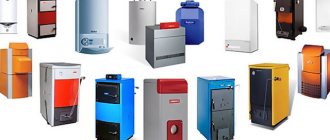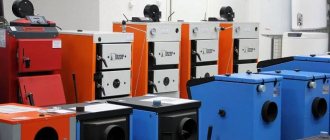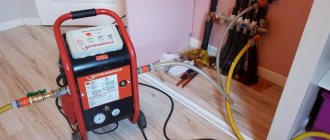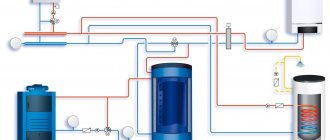Despite the fact that an induction boiler costs 2-3 times more than its heating element counterpart, an increasing number of users prefer this type of heater. Thanks to its simple and trouble-free design, the unit is durable and maintenance-free. Due to the high power, the connection of the installation must be coordinated with the Distribution Zone.
The induction boiler has a safe design.
The history of the appearance of heating equipment
The prerequisite for the creation of heat generators of this type was the discovery of electromagnetic induction made by Michael Faraday on August 29, 1831. Before him, this phenomenon was observed by Francois Jean Dominique Arago, but could not explain and reveal it.
Induction is the occurrence of an electromotive force in a closed conductor when the magnetic flux passing through it changes.
This can be achieved in 2 ways:
- Varying field parameters. To do this, change the strength or direction of the current flowing in the electromagnet coil.
- The movement of the conductor relative to the field or vice versa. To do this, for example, a permanent magnet is rotated.
Later, this phenomenon was studied in detail by Jean Bernard Foucault. He called volumetric currents arising in a material under the influence of an alternating magnetic field eddy currents. This is due to the circular trajectory of the charges. They are also called Foucault currents, named after the researcher.
According to the Joule-Lenz law, electricity induced by a magnetic field causes an increase in the temperature of the conductor. E. Colby took advantage of this in his experiments on non-contact heating of steel. In 1900, in the Swedish city of Jaising, she built the first induction melting furnace with a power of 78 kW. The project manager was engineer F. Kjellin.
In 1900, the first induction melting furnace was built.
Subsequently, the technology was developed and began to be used to solve a wide range of problems, in particular:
- ultra-pure smelting, soldering and welding of metals;
- bending and heat treatment of machine parts;
- creating jewelry;
- disinfection of medical instruments;
- heating miniature workpieces that are at risk of damage when in contact with gas-flame and arc equipment;
- surface hardening, including products of complex shapes;
- activation, training and degassing of cathodes in the production of vacuum electronic devices.
Due to the large size of the first installations, this method was not initially used in everyday life.
Later they began to produce:
- kitchen stoves;
- water heaters;
- heat generators.
Video description
Video example of making an induction heater:
- Creation of an inductor. An insulated copper wire with a cross-section of about 1-1.5 mm2 is tightly wound around the tube. The number of turns must be at least 90.
- Selecting a suitable alternator. The simplest and most affordable way is to use an inverter from an appropriate welding unit.
- Connecting the heater with the inductor to the water supply or heating pipe.
- Connecting the inductor to the network. The contact wires from the coil are connected to the positive contacts of the inverter.
- Power supply. Rectifier diodes are installed at the terminals. Without them, the voltage of the supplied current will be supplied rectified, and the coil will function as an electromagnet rather than an inductor.
- Turning on and checking the operation of the device.
Note! A self-made heater, unlike factory-made analogues, is not equipped with a protection and control system. Therefore, before turning it on, you must make sure that the heating element is filled with water.
General information about induction heating boiler
The production of such units began in the 90s. last century. Many models are cylindrical in shape, so they fit well even in small spaces.
Purpose of the inverter
The most expensive models are equipped with an electrical converter that processes the mains current as follows:
- straightens;
- again makes it variable with a frequency of up to 80 kHz instead of the standard 50 Hz.
Inverters are equipped with an electrical converter.
At the first stage, a simple diode bridge is used. On the second there is a circuit of fast-acting key transistors and a microprocessor that controls them.
Increasing the frequency of the current leads to a similar change in the magnetic field it generates. As a result, the so-called skin effect. It consists in the fact that due to the interaction of constantly changing primary and secondary fields, free charge carriers are displaced into the surface layers of the product. As a result, the current density increases, and hence the heating intensity, since, according to the Joule-Lenz law, these quantities are interrelated:
ω = j*E.
The temperature deep within the material increases due to thermal conductivity. As the frequency of the inductor's magnetic field increases, the layer thickness decreases. As a result, the current density increases.
Specifications and functionality
The device passport indicates the following parameters:
- power;
- voltage – 220 or 380 V (1- or 3-phase);
- dimensions and weight;
- installation method - wall or floor;
- highest coolant temperature;
- maximum pressure in the tank.
The induction boiler has a high efficiency of up to 99%.
Often referred to as efficiency. But this is a marketing ploy - any electric boiler, regardless of its operating principle, operates with 99% efficiency.
The weight of a 15 kW unit is 15 kg (Comfort brand unit), 5 kW – 11 kg (ELC Indukcion).
Functionality:
- Smooth launch. This eliminates sudden voltage fluctuations in the home network.
- Power adjustment within a wide range. For example, a heater with a nominal capacity of 6 kW has 3 stages of 2 kW each.
- Maintaining the coolant temperature within user-specified limits. The device automatically selects the desired mode and turns off if necessary.
- Programming. The user sets the heater operating schedule for each day of the week. For example, on weekdays from 8-00 to 17-00. When no one is home, the coolant temperature is set to a minimum.
- Room thermostat. Using a remote sensor, the device monitors the air temperature in the room and selects the optimal operating mode.
- Weather-compensated control. Some models also monitor the outside temperature and adjust performance ahead of time when it changes. This avoids wastage of energy.
- Remote control. The GSM module allows you to turn on the device and change its settings from your smartphone.
- Display of operating parameters on the screen. There are models with a touch screen.
The double-circuit unit additionally provides hot water supply in flow mode.
Many models are equipped with an expansion tank and pump.
Device
The device consists of the following components:
- Housings with thermal and electrical insulation.
- Boiler tank with core.
- A coil of wire wrapped around it, filled with a compound.
- Automation block.
- Terminal box for cable connection.
Installation of an induction boiler.
Principle of operation
The operation of the boiler is based on the induction effect. Part of the work done by electric current is spent on creating a magnetic field around the conductor. If it is assembled into a coil, this share increases many times over. Thus, the boiler winding acts as an electromagnet-inductor that generates an alternating field.
It induces Foucault currents in the heat exchanger and core, thereby causing them to heat up.
Calculation of other indicators when choosing a boiler
The main element of individual heating is a boiler, and which one should you have, gas or electric? boiler depends on a number of factors. Such as distance from the energy source (whether gas or electricity), time of residence according to the seasons (dacha, residential building). The price you are willing to pay for the device itself and its installation is also important.
But the most important thing when choosing is always the thermal calculation, because based on it, home owners give preference to one or another device with the required power. A single-phase electrode electric boiler is installed, as a rule, by owners of houses with an area of no more than 300 m2.
Approximate scheme for heating a house with electricity
It is enough to have access to a 220 V outlet and a small installation space; it can serve as both the main source of heat and work during the inter-heating period for heating. But first, it wouldn’t hurt to delve into the structure of the device in more detail; this will help to more accurately calculate the desired model.
Also pay attention to the following indicators:
- Purpose of the boiler, heating or also hot water for domestic needs.
- Storage tank volume.
- Coolant volume for the heating circuit.
- The area of the heated room.
- What current is the network designed for?
- Device power.
Main types
Different types of boilers differ in the design of the heat exchanger:
- Casing. The device consists of 2 parts located inside and outside the coil.
- Volumetric or inductive-conductive. The boiler tank is located inside the winding and contains a ferrite core.
- Tubular. The first induction heaters belonged to this type. The heat exchanger is a set of pipes that go around the winding.
The units are also divided into models with and without an inverter.
Operating principle
First, let's talk about the general operating principle of such heaters. As you know, when a direct current circuit is turned on or off, an electromagnetic field is formed, which, in turn, creates a current in conductors located in a certain way. This action heats up the conductor on which it acts.
If we now imagine the action of ordinary alternating current having a frequency of 50 Hz , we will see that the action of the field will lead to even greater heating of the metal core. It is clear that, in some cases, high-frequency electric current can be applied, which is even more capable of producing heat.
This idea was used to create induction heating boilers. Now let's look at how exactly they are arranged.
The entire device is located inside a metal casing.
The heating element is seamless metal pipes that are located inside it. They are located inside a coil, which is placed inside a closed housing. An alternating electric current is passed through it, as a result of which the metal pipes and, accordingly, the liquid that flows through them are heated.
For this purpose, ordinary water or other specialized types of liquids can be used. Typically, in order to circulate the liquid, a pump is used to push water through the pipes.
An important feature of this type of heating is the presence of microvibration, which plays an important role in preventing scale formation in pipes. In addition to water, antifreeze or, for example, machine oil can also be used as a coolant.
Main advantages of use
Compared to heating elements, non-contact heating boilers have the following advantages:
- Resistant to voltage surges. They can even withstand lightning strikes and zero ground breaks.
- Reliability and durability. These qualities are due to a simple design: the working part of the boiler consists of a pipe and a wire wound around it.
- Heat exchanger tightness. Its integrity is not compromised, so leaks are excluded.
- No scale. According to the manufacturers, it is not formed due to microvibrations of the heat exchanger walls.
- Large heating surface area. It is multiple times higher than that of the heating element. This ensures rapid heating of the coolant.
The induction boiler is resistant to voltage surges.
Compared to gas, solid fuel and diesel analogues, induction is superior because:
- Does not produce exhaust and does not require a chimney.
- It works silently.
- Able to regulate power over a wide range and at high speed.
- Due to the absence of fire, it is not a fire hazard.
- It is equipped only with electronic automation, which means it has all modern functions - programming, weather control, etc.
No heating element
First, the electric boiler is induction, supposedly there are no heating elements. But in a heating element, sometimes there are more than a dozen of them, which means there is a high probability of them breaking, maybe several at once.
But if there were no heating element, then how would the boiler heat the water? The same coil essentially performs this role, only without contact with the liquid. Therefore, this element is present in any such unit.
But as for the high probability of heating elements failing, this directly depends on the product and manufacturer that you buy.
There are specialists who have installed more than 500 heating element boilers over the years of their work, and have not changed a single element under warranty during all this time.
Criteria for choosing a good boiler: what to look for
When purchasing a unit, consider the following:
- Power. For a standard house, 1 kW is required for every 10 square meters. m area.
- Voltage. The 380 V model is suitable only for those who have 3 phases connected to their house.
- Maximum pressure in the boiler tank. It must withstand the load from the pump and the weight of the water column.
Models with several power levels are preferable - when starting, they do not cause a sharp drop in voltage in the network.
When purchasing a unit, consider the power and voltage.
Due to the high cost of electricity, it is recommended to choose a boiler with functions that allow you to use energy economically:
- with weather-compensating automatic;
- programmable.
Advantages and disadvantages
Advantages of induction heating equipment:
- Increased reliability and operational safety through the use of automation. The use of various liquid coolants is allowed.
- Increased boiler efficiency exceeding 90%. The parameter depends on the design features of the heat exchange circuit.
- Extended service life exceeding 25 years. To increase reliability, coils with spaced winding turns are used. The gap between the wire is filled with a heat-resistant compound. Friction parts are excluded from the equipment circuit (except for quick-release electric pumps), which further reduces the likelihood of equipment failure.
- Quick start of work due to reduced product dimensions. Since an electric induction boiler does not have massive metal structural elements, heating of the liquid begins after the power is turned on.
- The vibrating induction heating element is not covered with a layer of scale. To reduce the likelihood of deposits forming, special fluids are used. The absence of deposits allows you to maintain uniform power during operation of the device. To improve functional characteristics, it is recommended to introduce reagents into the working fluid that prevent the formation of deposits.
Disadvantages of heating equipment with the induction principle of heating liquids:
- Constant monitoring of the fluid level in the lines is necessary. If there is a leak, the working core overheats, causing the heating boiler to fail.
- Increased price of equipment and installation.
- The process of self-repair is difficult. There is no provision for dismantling some of the structural components, which increases the cost of restoration work.
- High-frequency noise during operation of some devices. It is not recommended to install such equipment in residential premises.
Review of popular manufacturers and models
More and more companies are mastering the production of induction boilers. Some brands have become especially popular.
VIN
The brand belongs to the “Alternative Energy” thermal equipment plant. The company produces induction-conduction heaters with volumetric heat exchangers. All boilers are equipped with inverters. The cost is 37-40 thousand rubles.
VIN – heater with a volumetric heat exchanger.
SAV
Equipment of this brand is produced by NPK INERA.
Peculiarities:
- shell heat exchanger;
- lack of inverter.
The devices operate at a standard network frequency of 50 Hz. Because of this, they are larger than inverter ones, but cost less - 27-32 thousand rubles.
"Geyser"
The brand belongs to the Kostroma Boiler Equipment Plant. The company produces a series of heaters with a rated power of 5, 10, 15, 20, 25, 50, 100, 250 kW. The first requires a voltage of 220 V, the others - 380 V.
Geyser units are of the inductive-conductive type.
All units are of the inductive-conductive type.
"Edison"
The model range of this brand includes heaters with a rated power of 4.7, 13, 22, 50, 100, 250, 500 kW.
The most productive installation is capable of heating an object with an area of 5000 square meters. m. Its weight is 1.5 tons.
The minimum price for Edison products is 35 thousand rubles.
The models are not equipped with inverters, so the youngest representative of the line weighs 40 kg with a power of 4.7 kW.
"Miratron"
The company offers several induction heaters with capacities ranging from 6 to 30 kW. The company uses only high-quality materials in the manufacture of units. All of them have a connector for connecting a weather sensor, and a programming function is provided.
"Miratron" is an induction heater made of high-quality materials.
A 6 kW model costs 45 thousand rubles, a 15 kW model costs 65 thousand rubles.
Connections and flanges
The second drawback in comparison is the large number of sealing connections (heating elements, flanges) and their complete absence in an induction boiler. Here these advantages and disadvantages can even be swapped.
After all, if the heating element does fail, you can easily replace it. Or simply exclude it from the circuit for a short time, set the jumpers differently and continue working.
But if the coil burns out (due to an interturn short circuit), how much will the repair cost you? And will you be able to keep warm with such a breakdown?
DIY methods
Thanks to a simple device, you can make a small induction heater yourself.
The easiest way is to install an electromagnet next to the cast iron battery. Home craftsmen also assemble more efficient designs.
From a welding inverter and plastic pipes
This is the most common option.
Proceed in the following order:
- Take a piece of thick-walled plastic pipe DN50 0.5 m long. Most often, a product made of polypropylene is used.
- Using a special heater, weld the coupling on one side, after inserting a circle of metal mesh into it. The part must completely cover the end of the pipe.
- Pour scraps of stainless wire 7 mm thick and up to 5 cm long into the water heater. They will serve as a core.
- Cover the second end of the pipe with a metal mesh and weld the coupling.
- Wind 90 turns of enameled copper wire around the body. This is an inductor coil.
- Connect a 15 A welding inverter with a smooth current control function to the wire.
The device can be made from a welding inverter.
It is permissible to replace couplings with fittings with metal threads.
The heater is ready, you can connect it to the pipeline.
Examples of homemade designs
If you are not going to use an induction boiler for main heating in a private house, but want to equip a cottage or garage with it, then you can try to design it yourself. There are two options on how to do this.
First option
To implement it you will need pieces of plastic pipes and a welding inverter. Having basic knowledge of physics and knowing how to use wire cutters, you can independently make a basic induction model. To do this, you need to purchase an already created high-frequency welding inverter with continuously adjustable current power up to 15 amperes or even higher. To heat a large area, it is better to choose a much more powerful device. You will also need stainless steel wire rod or regular pieces of steel wire. This is necessary to act as a heated element. Their length is about 50 mm, with a diameter of 7 mm.
An important component is copper wire, which can be easily purchased at any specialty store. Do not use windings from old coils. The housing, which is the basis of the induction coil, is also part of the pipeline, so it can be made from a plastic pipe with thick walls. Its internal diameter should be 50 mm. Two outlet pipes are attached to this housing for the flow of cold coolant and the release of hot coolant. The entire internal space of the case must be completely filled with pieces of wire and covered with a metal mesh so that they do not spill out.
This is what a homemade induction device might look like
An induction coil is made as follows: an enamel-coated copper wire is gradually wound around a previously prepared plastic pipe. It will take approximately 90 turns. The resulting homemade device needs to be connected to the pipeline network. A small section of pipe is cut out of the pipeline, and a homemade induction boiler is installed in its place. It is connected through an inverter and the water is simply turned on.
Second option
This option involves the use of a three-phase transformer with the possibility of fixation. In addition, you will also need a welding machine. To make the device, you need to weld two pipes so that they look like a donut in cross-section. This design performs both conductive and heating functions. Then the winding is wound directly onto the boiler body in order for it to operate more efficiently, despite its low weight and size. A standard coolant heating scheme is used here: it receives a large amount of thermal energy upon contact with the winding.
Homemade induction boiler from a transformer
The manufacturing scheme for this design is somewhat more complicated than in the first version. The boiler is equipped with two pipes, both for the entrance of the cold coolant and for the exit of the heated one. If you come up with and build a protective casing yourself, you can minimize heat losses.
Self-installation instructions
When installing the device between it and building structures, maintain the following minimum distances (cm):
- walls – 30;
- floor and ceiling – 80.
The device is leveled in a strictly vertical position.
Connecting the boiler to the heating system
Induction heaters are intended only for closed circuits with forced circulation of coolant.
There are 2 reasons for this:
- high hydraulic resistance;
- high heating rate - the medium boils before it has time to escape into the system under the influence of convection.
Induction boiler connection diagram.
Therefore, the circuit must be equipped with:
- Circulation pump with mesh filter. It is connected to the boiler on the “return” side.
- Diaphragm expansion tank. Placed right there.
- Safety group consisting of a pressure gauge, air vent and safety valve. It is installed on the “supply” side no further than 0.5 m from the boiler without any fittings in this area.
The “return” is connected to the heater from below. “Feed” – to the upper pipe.
Electrical connection
The device is supplied with its own cable from the distribution board. The cross-section of the conductors is selected according to the amount of current consumed. The line is protected by a circuit breaker and an RCD. The boiler body is grounded.
Effective ways to save energy
The most effective way to save money is to install a multi-tariff meter, however, it must be borne in mind that this method already incurs considerable costs for its purchase and installation.
Multi-tariff meter (right)
Power limiters also cope very well with this task. After all, during the day we load the network in surges. The most logical thing would be to heat the house at night from 22:00 to 6 o'clock. For efficient heating operation, use a circulation pump; it is installed in the return network.
Operating rules and maintenance
Do not do the following:
- Fill the system with a coolant that is not listed as permitted by the manufacturer.
- Turn on the device in dry running mode or with the pump stopped.
- Carry out repair or maintenance work without turning off the power to the unit.
- Keep metal objects near the heater.
The device cannot be turned on in dry code mode.
Check periodically:
- performance of the RCD;
- ground loop resistance.
Induction heaters do not require maintenance. In rare cases, the heat exchanger may become covered with scale, then it is washed with a solution of citric acid or a special product. To eliminate such phenomena, fill the system with demineralized water.
Loosening contacts
Terminal contacts in heating element models, most of them, can be in temperature difference mode. Heating at maximum load, and cooling when switched off.
And this imposes obligations for their revision and tightening.
And in induction, there are supposedly no electrical contacts. In fact, they are always and everywhere, including induction ones.
But as for the former, in recent years specimens with high-quality screw clamps have begun to be produced.
Or there may be screw connections with a locking washer, which do not require maintenance, or spring clamps, which also go without control and revision for years.
In fact, these are just made-up benefits.
Approximate cost of induction heating for a private house
In rated power mode, the boiler operates only a small part of the time - when the outside temperature drops to extremely low values. In a building built in accordance with energy saving standards, the average performance of the heat generator for the entire cold season is 1/3 of the maximum.
Let the area of the house be 150 square meters. m. Then:
- rated power of the device at the rate of 1 kW per 10 sq. m – 15 kW;
- the average for the heating season is 5 kW.
If the duration of the cold period is 7 months (213 days), the total energy consumption is equal to:
Р=5*24*213=25560 kW*h.
The cost of 1 kWh in rural settlements, for example, the Samara region, as of the first half of 2022 is 3.02 rubles.
The costs for an induction boiler will be high.
Heating costs will be:
Z=25,560*3.02=77,190 rub. for 7 months or 11,027 rubles. for 1.
Of all types of heating, electric is the most expensive.
To reduce costs, proceed as follows:
- Switching to a 2-part tariff. For villages and hamlets of the Samara region. the price of 1 kWh at night in 2022 is 1.66 rubles.
- A heat accumulator is installed in the heating system. This is a large container encased in mineral wool.
The boiler operates only at night, heating the liquid in the storage tank to +95°C. During the day, the heating circuit, as needed, selects hot water from the tank through a mixing unit.
The costs in this case will be:
Z=25,560*1.66=42,430 rub. for 7 months or 6061 rub. for 1.
In this scheme, the boiler works at night simultaneously on the heating system and on the battery. Therefore, we need a model with 2 times the power - 30 kW.
Decrease in electric boiler efficiency
Another argument for comparison is that an induction boiler does not lose its original power during operation. But with heating element, due to scale formation, this happens as a matter of course.
Even sometimes calculations are given, according to which, within just one year, the power of a heating element decreases by 15-20%. This means that its efficiency also decreases.
Let's look at this in more detail.
Almost any electric boiler has an efficiency exceeding 98%. And even boilers operating at ultra-high frequency currents from 25 kHz and above, what can they change for you? Add an extra one and a half percent, but at the same time jump the price by 100%?!
As for deposits on the heating element element, they are indeed present.
In water supply systems in direct heating boilers, a certain “scale” is deposited on the working element. It actually gradually prevents the water from heating up quickly.
What happens where there is no constant supply of impurities? A small layer of deposits may settle on the heating element, however:
- this layer is not thick enough
- it does not in any way interfere with heat transfer
For example, let’s assume that on a clean surface of the heating element, heat transfer occurs at t=60 degrees. As soon as this surface becomes contaminated with deposits, heat exchange will not disappear anywhere, but will begin to occur at high degrees, say 75-80C.
And accordingly, the boiler in no way loses its original efficiency.
That is, in fact, both on a clean heating element and on a dirty one, the same amount of energy is transferred, only at different temperatures.
Negative sides of boilers
The disadvantages of induction heaters are:
- High price. The device costs 2-3 times more than its heating element counterpart.
- Large weight and dimensions. Household models generally weigh from 40 to 80 kg.
- High cost of energy resources. In Russia, the average cost of an electric kWh is 3.5 rubles, while that obtained from burning main gas is only 0.5 rubles.
- Difficulty connecting. According to the standards, only 5-7 kW is allocated for an apartment and a house; if there is an electric stove, it is 88-11. To increase the limit, you need to obtain permission from the Distribution Zone and replace the supply cable. There have been cases when, in order to connect a 15 kW boiler, people had to pay for the replacement of a transformer at a substation.











